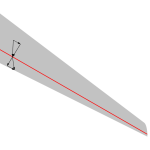
Not all airplanes have straight wings that extend perpendicular to the fuselage. While straight wings are common, some airplanes have wings that extend from the fuselage at an angle. Known as swept wings, they can extend forward or backward. Below are several facts about swept-wing airplanes and how they work.
#1) Common With Supersonic Airplanes
Swept wings are common with supersonic airplanes. The term “supersonic” refers to aircraft that can exceed the speed of sound, which is 767 mph. Swept wings change the way in which air flows over the airplane’s wings, thereby delaying the onset of the initial shock wave and the associated drag it creates.
#2) Changes the Airplane’s Center of Gravity
Swept wings change the airplane’s center of gravity. There are forward- and backward-swept wings. Forward-swept wings push the airplane’s center of gravity forward, whereas backward-swept wings push it backward.
#3) Originated in Early 1900s
Most people assume that swept wings are a relatively new trend in aerospace design. However, they’ve actually been around for well over a century. The first airplane with swept wings originated in the early 1900s. Known as the Burgess-Dunne biplane, it was designed by J. W. Dunne. After a few variants were developed, the Burgess-Dunne biplane successfully made it across the English Channel.
#4) Sweet Angles Can Reach 45 Degrees
The degree of sweep can vary. Straight-wing airplanes have a 0-degree sweep angle, meaning the wings are perpendicular to the fuselage, without extending at an angle. Swept-wing airplanes, on the other hand, have a sweep angle of up to 45 degrees. A 45-degree sweep angle means the wings extended at a 45-degree angle — either forward or backward — from the fuselage.
#5) Used in Commercial Aviation
Swept-wing airplanes are limited to military aviation. While there are many swept-wing fighter jets, there are swept-wing commercial jets. For commercial aviation, swept-wing airplanes became popular in the 1950s and 60s. They allow for faster cruising speeds and better fuel efficiency when compared to straight-wing airplanes.
#6) Increases Stalling Speeds
While swept wings have plenty of advantages, they also come with some disadvantages. One of the main disadvantages of swept wings is increased stalling speeds. Stalling speed is the minimum speed an airplane must fly to maintain sufficient lift. If an airplane drops below this speed, it will essentially fall from the sky. With swept wings, airplanes typically have a higher stalling speed, which requires them to take off from longer runways.



